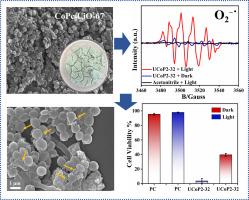Visible light-activated cobalt phthalocyanine/UiO-67 composite: A novel approach to photodynamic antibacterial therapy
IF 3.2
2区 化学
Q2 BIOCHEMISTRY & MOLECULAR BIOLOGY
引用次数: 0
Abstract
Metallophthalocyanines (MPcs) are highly promising photosensitizers owing to their exceptional photoelectronic properties, yet their practical photocatalytic applications are often limited by strong π–π self-aggregation. In this study, we report a facile in situ strategy to incorporate cobalt phthalocyanine (CoPc) into the porous matrix of UiO-67 metal-organic frameworks (MOFs), effectively suppressing aggregation and enhancing photo-activity. The resulting composite, UCoP2–32, exhibited outstanding antibacterial photodynamic therapy (APDT) performance under visible light, achieving over 96 % inactivation of methicillin-resistant Staphylococcus aureus (MRSA) within 12 min of light exposure. Photophysical studies confirmed the efficient generation of both type-I and type-II reactive oxygen species (ROS), with superoxide and hydroxyl radicals predominating, and electron spin resonance (ESR) analysis supported this mechanism. Moreover, UCoP2–32 demonstrated excellent biocompatibility with minimal hemolysis (∼6.4 % at 110 μM) and structural stability. This work provides a robust and broadly applicable strategy for integrating MPcs into MOFs, offering significant potential for the development of high-performance photocatalytic materials in antimicrobial and other light-driven applications.

可见光活化的酞菁钴/UiO-67复合材料:光动力抗菌治疗的新方法
金属酞菁(MPcs)由于其特殊的光电子特性是非常有前途的光敏剂,但其实际的光催化应用往往受到强π -π自聚集的限制。在这项研究中,我们报告了一种简单的原位策略,将酞菁钴(CoPc)加入到UiO-67金属有机框架(MOFs)的多孔基质中,有效抑制聚集并增强光活性。该复合材料UCoP2-32在可见光下表现出出色的抗菌光动力治疗(APDT)性能,在光照射12分钟内实现超过96%的耐甲氧西林金黄色葡萄球菌(MRSA)失活。光物理研究证实了i型和ii型活性氧(ROS)的有效生成,其中超氧化物和羟基自由基占主导地位,电子自旋共振(ESR)分析支持了这一机制。此外,UCoP2-32表现出优异的生物相容性,具有最小的溶血(在110 μM下约6.4%)和结构稳定性。这项工作为将MPcs集成到mof中提供了一个强大且广泛适用的策略,为抗菌和其他光驱动应用中的高性能光催化材料的开发提供了巨大的潜力。
本文章由计算机程序翻译,如有差异,请以英文原文为准。
求助全文
约1分钟内获得全文
求助全文
来源期刊

Journal of Inorganic Biochemistry
生物-生化与分子生物学
CiteScore
7.00
自引率
10.30%
发文量
336
审稿时长
41 days
期刊介绍:
The Journal of Inorganic Biochemistry is an established international forum for research in all aspects of Biological Inorganic Chemistry. Original papers of a high scientific level are published in the form of Articles (full length papers), Short Communications, Focused Reviews and Bioinorganic Methods. Topics include: the chemistry, structure and function of metalloenzymes; the interaction of inorganic ions and molecules with proteins and nucleic acids; the synthesis and properties of coordination complexes of biological interest including both structural and functional model systems; the function of metal- containing systems in the regulation of gene expression; the role of metals in medicine; the application of spectroscopic methods to determine the structure of metallobiomolecules; the preparation and characterization of metal-based biomaterials; and related systems. The emphasis of the Journal is on the structure and mechanism of action of metallobiomolecules.
 求助内容:
求助内容: 应助结果提醒方式:
应助结果提醒方式:


